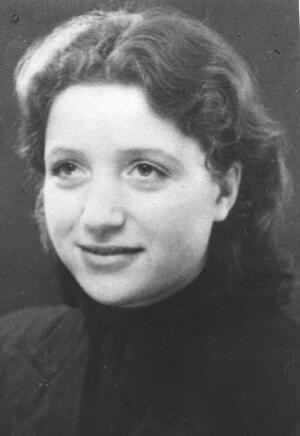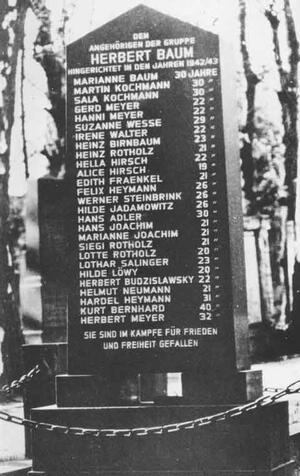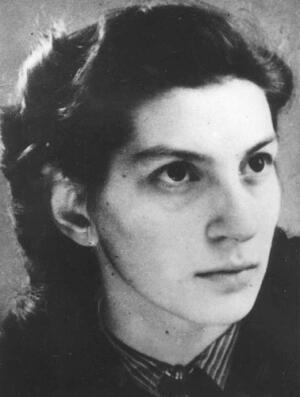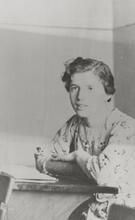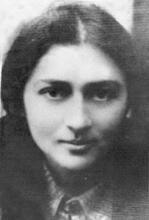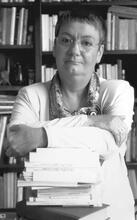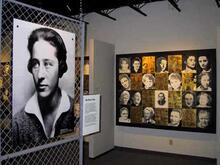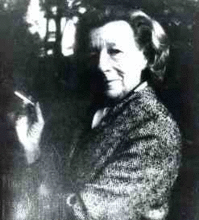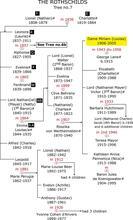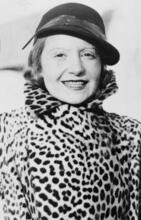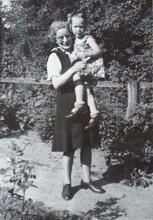Baum Gruppe: Jewish Women
Formally created in 1938 and 1939, the Baum group was a German anti-Fascist resistance organization. The group was comprised of almost equal numbers of men and women and was almost entirely Jewish, but the youthfulness was particularly characteristic of its female members. After war broke out between Germany and the Soviet Union in mid-1941, the Baum group’s activity developed from writing and distributing anti-Fascist posters and propaganda to active resistance against the Nazi regime. On May 18, 1942, the Baum group joined another resistance organization in its attempt to set fire to an anti-Soviet exhibit at a public park in Berlin. The damage was minimal and shortly thereafter, the Gestapo arrested hundreds of Jews in retaliation and twenty-two members of the Baum group were executed.
Introduction
On May 18, 1942, two anti-Nazi Communist groups set fire to the anti-Soviet exhibit, Das Sowjetparadies (The Soviet Paradise), which was held in the Lustgarten in Berlin. The larger, leading group of the two, almost entirely Jewish in its composition and led by Herbert Baum, was known as the Baum Gruppe. Damage was minimal and the exhibition was reopened the following day. Nine days later, on May 27, 1942, the Gestapo arrested an unspecified number of Jews and incarcerated them in the internment camp at the Lewetzowstrasse Synagogue. On May 28, one hundred and fifty-four of them were taken to the SS camp in Lichterfelde and shot immediately upon arrival. Ninety-six other Jews were taken out of the evening roll call that same day and also shot. The family members of the Jews who had been shot in Lichterfelde were sent to Theresienstadt in various transports. Two hundred and fifty other Jews from Berlin were deported to Sachsenhausen. Some were shot there, and others sent to Auschwitz.
Most of the members of the two resistance groups were quickly captured by the Gestapo and tried and sentenced in Berlin. Except for three of the youngest women, all were sentenced to death. The condemned were beheaded in the Berlin-Plötzensee prison. In all, twenty-two members of the group were executed. Herbert Baum died in his cell. According to the Gestapo he committed suicide, but group members and researchers believe he was murdered. Three of the women who did not receive death sentences were sent to Auschwitz, where they perished. Two other women members were sentenced to death but reprieved, each under different circumstances. The Gestapo also arrested supporters and helpers of the group who were not themselves members, sentenced most of them to death and executed them. Of the immediate circle of young men in the group, the sole survivor was Richard Holzer, who managed to flee to Hungary, where he was recruited into the Jewish forced-labor companies on the eastern front. He was captured by the Soviets but managed to prove his identity and returned to Germany after the war.
The Women of the Baum Group
A significant characteristic of the Baum group was its youthfulness, which was particularly characteristic of the women members. In 1941, the average age of the members was twenty-two. Alice Hirsch was the youngest at eighteen, followed by Hildegard Löwy, who turned nineteen that same year. Charlotte Päch, aged thirty-two, was nicknamed “Grandma.” Only five members were over twenty-one years of age in 1933, the year Hitler came to power, while the majority were then between the ages of ten and thirteen. Most of the young women in the group were friends or lovers of a man in the group, and some were already married. Two had children. This confirms testimonies about their motivation to join a group and the references to a search for community, support, solidarity, friendship, and love. Many of them came to the group from Jewish or other youth movements that had either been disbanded after the pogrom of November 9 and 10, 1938 (“Kristallnacht”) or had dwindled rapidly as a result of emigration. The group comprised almost equal numbers of men and women. The small inner circle around Herbert Baum had fourteen members, seven of them women. Three women and one man were more marginal.
In the wider circle, the Heinz Joachim group, which was more like a sub-group in itself, there were seven members: three women and four men. The entire group was thus balanced so far as gender was concerned. In addition, of the twelve members who took part in the torching of the exhibit, five were women.
The main pool of human resources on which the Baum Gruppe drew was Jewish youth organizations. After Hitler’s rise to power, the leadership of the Communist youth organization instructed Baum to contact Jewish youth movements and organizations and recruit them to resistance. In consequence, Baum joined the Ring-Bund Deutsch-Jüdischer Jugend at the beginning of 1934.
From the middle of 1934, Baum assumed leadership of the Communist youth organization in the southwestern sub-district of Berlin. Even before Hitler’s rise to power, Baum managed to work in several Jewish youth movements. The core of a resistance group under his leadership came from this framework. This was where he met Marianne Cohen, his wife-to-be, and Sala and Martin Kochmann. In contemporary leftist jargon their activity was termed “the Trojan Horse tactic,” the goal of which was to recruit members by infiltrating into other organizations, some of which were close to their world view while others opposed it. Later on, after the “Brussels Congress” of the German Communist Party which took place in Moscow in October 1935, activity in the Jewish youth organizations had another goal: to provide legal camouflage for Communist activists, since the Jewish and especially the Zionist youth movements remained legal until after the November pogrom. At that same congress, the Communists decided to expel Jewish members from Communist underground cells. This was in order to protect both the Jewish members and the cells themselves. Thus, the conditions were created for the Jewish youth organizations to serve as a recruiting pool for the Jewish Communist group which was taking shape.
The first organization of the group seems to have begun around the end of 1938 and beginning of 1939. This was the time when Jewish youth movements were outlawed, though they still managed to get most of their members out of Germany. Under these conditions, the organization became a kind of “city of refuge” for members of Jewish youth movements and organizations who for one reason or another had not left Germany.
There were only a few members in Herbert and Marianne Baum’s immediate circle: Sala and Martin Kochmann, Heinz Birnbaum, Felix Heymann, Alfred Eisenstadter and Gerd and Hanni Meyer. Two non-Jewish women joined them: Irena Walther, who was friendly with one of the members, and Suzanne Wesse, a Frenchwoman who had been married to a Berlin resident and had remained in Berlin after her divorce.
At this stage, the group’s activity was mainly social and ideological. They went on outings, listened to music, held poetry readings, and participated in other, similar activities. On the ideological side, they concentrated on the study of Marxism, reading the relevant literature and holding discussions. Only in mid-1941, after war broke out between Germany and the Soviet Union, did their activity develop into active resistance to the regime. This took the form of composing, printing and distributing anti-Fascist posters and propaganda material and, finally, the attempt to blow up the anti-Soviet exhibit.
Despite the membership of several “refugees” from Zionist youth movements such as Ha-Bonim and Ha-Shomer ha-Za’ir, the group’s membership in the German Communist Party was clear and absolute, even though there were differences of opinion in the group’s discussions (including one about the need and justification for the torching of the exhibit). But Herbert Baum’s leadership of the group was unassailable. Marianne Baum, his wife, comes across as a woman with important social influence in the group, but she was at the side—and perhaps even in the shadow—of her husband.
Biographical Sketches
Marianne Baum (née Cohen)
Born February 9, 1912, in Strassburg, she left her home in Alsace circa 1920, eventually moving to Berlin. At the end of the 1920s she was a member of the Deutsch-Jüdischen Jugendgemeinschaft, where in 1928 she met Herbert Baum, whom she later married. In 1931 she joined the Communist youth organization, KJVD. In 1940 she worked at forced labor in the Jewish department at the Siemens electric motors factory. Alongside Herbert Baum, she was a central figure in the organization. Together with her friends, she took part in the torching of the anti-Soviet exhibit and was arrested on May 22, 1942. On July 16, 1942, she was tried by a special court in Berlin and sentenced to death. She was executed in Berlin-Plötzensee Prison on August 18, 1942.
Edith Fraenkel
Born in Berlin on February 8, 1922, Fraenkel studied at the Rudolf Steiner Anthroposophic School for the first ten grades and then began studying commerce. From 1938 she helped her mother, Olga Frankel, run her household, which also served as a Jewish restaurant. In 1937 she met Harry Cohan, whom she married. Their son, Uri, born on June 2, 1941, died in hospital six months later. From the end of 1940 she participated, together with Harry Cohan, in the discussions and study meetings of Herbert Baum’s group. She was arrested on July 18, 1942. On December 10 of that year, she was sentenced to five years in prison. In October 1943 the Gestapo in Berlin transferred her from the women’s prison in Cottbus and on October 17, 1943 she was deported to Theresienstadt. From there she was eventually sent to Auschwitz and murdered.
Alice Hirsch
The youngest of the group, Hirsch was born in Berlin on September 22, 1923. In 1933 she transferred from the German Margarethen-Lyceum School to the Jewish elementary school on Auguststrasse. She worked as a cleaner in Jewish homes for about half a year and then was unemployed. She later worked in industry for eight weeks. For about a year and a half beginning in 1939 she worked on the national union training farm in Algut, Upper Silesia. Finally, she worked for the firm of Max Schade, where she was arrested on July 8, 1942. On December 10, 1942 she was sentenced to three years in prison and transferred to the Berlin Gestapo from the Cottbus prison in October 1943. On October 14, 1943 she was sent to Auschwitz, where she was murdered.
Hella Hirsch
Alice’s older sister was born on March 6, 1921 and studied first at the Margarethen-Lyceum School and then up to the first grade of a Jewish middle school. Between April 1937 and March 1939, she studied commerce at the firm of Zeidler and Remark. From June 1939 to June 1941, she was the assistant of Dr. Fritz Hirschfeld. Finally, she was taken to forced labor at I. G. Farben. From the beginning of May 1942, she lived illegally at Fredersdorf near Berlin in the home of Frau Westphal. She was arrested on July 8, 1942 and sentenced to death on December 10, 1942. She was executed in the Berlin-Plötzensee Prison on March 4, 1943.
Charlotte Holzer (née Abraham)
Born on December 7, 1909 in Berlin, Holzer attended elementary school in Berlin and trained as a nurse in the Jewish infants’ home in Niederschönhausen. She had additional training at the Jewish hospital on Iranische Strasse, where she worked until shortly before her arrest. She met Herbert Baum and Marianne Cohen in the Jewish youth movement DJJG but was not in contact with them until 1939/40. At the beginning of the 1930s she joined a new Communist cell that was founded in the Jewish hospital. There she met Gustav Päch, who lectured in the study circles of revolutionary organizations. They married in 1932 or 1933 and in the same year had a daughter, Eva. In August 1933 Gustav Päch was arrested, convicted of conspiracy and sentenced to sixteen months’ imprisonment. After his release, the couple drifted apart, and Charlotte lived alone with her daughter. In 1940 she met Herbert Baum, who was a patient at the Jewish hospital, and joined his group. There she met Richard Holzer. She was arrested on October 8, 1942 together with Martin Kochmann, Felix Heiman and Herbert Bodzislavski and convicted of conspiracy. Her trial took place on June 29, 1943, while she lay ill with scarlet fever in the infirmary of the Leipzig-Kleinmaüsdorf women’s prison, where she was serving a sentence for economic war crimes (obtaining illegal ration coupons). Her case was separated from the others and never tried. She was moved to several prisons and labor camps in Berlin and finally survived in the camp at Schulstrasse. In June 1944 she managed to escape from the hospital on Iranische Strasse. After the war, Richard Holzer returned to Germany and married Charlotte Päch who, together with her husband, was one of the few members of the Baum Gruppe to survive and testify about their activity. She died on September 29, 1980.
Marianne Joachim (née Prager)
Born in Berlin on November 5, 1921, Joachim attended elementary school until the age of sixteen and continued at a Jewish middle school until her final examinations. She worked as a nursemaid at the Jewish children’s home. In 1940 she was sent to Rathenau with a work group for a year and a half and in 1941 worked in forced labor at the Alfred Teves factory in Wittenau. On August 22, 1941, she married Heinz Joachim; both were members of the Baum Gruppe. She is reported to have been lively and gifted with a sense of humor, joviality and wit. Marianne Joachim was arrested on June 9, 1942 in Rickstrasse and sentenced to death on December 10, 1942. She was executed on March 4, 1943 in Berlin-Plötzensee Prison.
Sala Kochmann
Born on June 7, 1912 in Rzeszow, Poland, Kochmann studied to become a kindergarten teacher and worked at the nursery school in Jerusalemer Strasse, Gipsstrasse. In 1938 she married Martin Kochmann. She was one of the first members of the group and active within it, participating in the attempt to set fire to the exhibit. Arrested on May 23, 1942, she tried to evade torture by jumping from the window of the police station and was critically injured. While she was in the Jewish hospital on Iranische Strasse, she conveyed information and warnings to the group members who had not yet been arrested via Charlotte Päch, a group member who was a nurse in the hospital. Taken to her trial on a stretcher, she was sentenced to death on July 16, 1942 and executed on August 18, 1942 in Berlin-Plötzensee Prison.
Hildegard Löwy
Hanni Meyer (née Lindenberger)
Born on February 14, 1921 in Berlin, she studied at middle school and at a private school for commerce. From April to October 1940, she studied to be a nursemaid at the Jewish community’s seminary, but her studies were interrupted. In October 1940, she worked in an electric bulb factory. On February 27, 1942, she married Gerd Meyer. She was a former member of the Ring-Bund Deutsch-Jüdischer Jugend. Arrested on June 3, 1942, she was sentenced to death on December 10, 1942 and executed on March 4, 1943 in Berlin-Plötzensee Prison.
Lotte Rotholz (née Jastrow)
Jastrow was born on September 25, 1923 in Bentheim. Her father was a maggid (preacher) and religious studies teacher employed by the Jewish community. In 1933 the family moved to Berlin. After elementary school, she studied to become a seamstress and later worked at the Spindler factory. On December 10, 1941, she married Siegbert Rotholz, and they lived together until their arrest. She was a member of the Ring-Bund-Deutsch-Jüdischer Jugend. On December 10, 1942, she was sentenced to ten years in prison. On October 14, 1943 she was sent to Auschwitz, where she was murdered.
Suzanne Wesse (née Vasseur)
Vasseur was born on January 16, 1914 in Calais, France. The daughter of an affluent industrialist, she attended school in England, Spain and Berlin. In 1934 she worked in a Jewish clothing firm in Berlin, where she met the engineer Richard Wesse. She returned to France and came back to Berlin in 1935. In 1936 she married Wesse, who according to the Nüremberg Laws was a mischling of the first degree. In April 1937 their daughter Katharina was born. Until June 1937 she worked as a freelance translator in Berlin. In June 1938, her brother, Amand Vasseur, came to Berlin. They met Felix Heiman and Sala and Martin Kochmann and joined Herbert Baum’s group. Amand returned to Paris in August 1939. Her brother, August Vasseur, was a prisoner of war and in 1942 was transferred to Stalag III A near Weckenwalde, where Suzanne was able to speak with him. She used her legal job in the office to make stencils for the group’s posters. On May 23, 1942, Suzanne and Richard Wesse were arrested at their home. Richard was released after three weeks in prison. Suzanne was sentenced to death on July 16 and executed in Berlin-Plötzensee Prison on August 18, 1942.
Be’er, Mark. Bletter far geshikhte. Warsaw: 1961, 27–64.
Brothers, Eric. Berlin Ghetto: Herbert Baum and the Anti-fascist Resistance. The History Press, 2012.
Cox, John M. Circles of resistance: Jewish, leftist, and youth dissidence in Nazi Germany. Vol. 62. Peter Lang, 2009.
Eschwege, Helmut. “Resistance of German Jews against the Nazi Regime.” In LBI Yearbook 15 (1970): 168–180.
Kwiet, Konrad, and Helmut Eschwege. Selbstbehauptung und Widerstand: Deutsche Juden im Kampf um Existenz und Menschenwürde 1933–1945. Hamburg: 1984, 114–139.
Loehken, Wilfried, and Werner Vathke. Juden im Widerstand: Drei Gruppen zwischen Ueberlebenskampf und Politischer Aktion, Berlin 1939–1945. Berlin: 1993, 114–117.
Maoz, Eliyahu. Yalkut Moreshet 3: 79–88.
Pikarski, Margot. Jugend im Berliner Widerstand: Herbert Baum u. Kampfgefährten. Militärverlag der Dt. Demokrat. Republik, VEB, 1978.
Wippermann, Wolfgang. Die Berliner Gruppe Baum und der judischer Widerstand 4–10. Berlin: Informationszentrum Berlin, Gedank und Bildungstatte Staufenberg, 1981.

